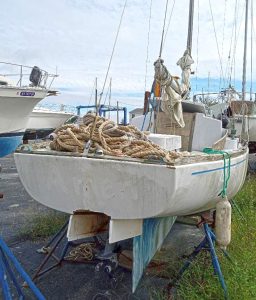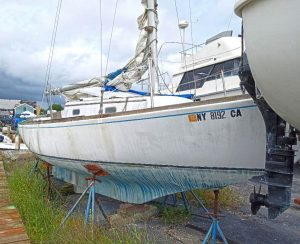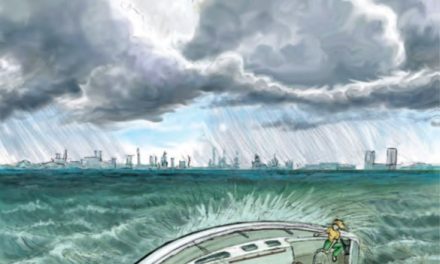From pocket cruisers to beloved classics, dying boats need to be saved.
Issue 155: March/April 2024

The author’s 1965 Sailmaster 22, rescued, restored, and sailing after 15 years on the hard.
Last spring, the yard where I store my sloop for the winter cleared out a small trove of derelict sailboats. An enterprising crew of Floridian salvagers, prospecting their way north in the pandemic’s wake, showed up at the gate looking for sailboats to scrap. They wanted the lead keels and aluminum spars, which left them a handsome profit even after paying to dump the old hulls, still outfitted with valuable hardware, at the landfill. For the yard, it was a win all the way around. Potential liabilities were removed, valuable winter storage space was reclaimed, and years of lost revenues were put to an end. For the scrappers, it was a quick if dirty buck.
The first boat to go, an Ericson 35, had been a regular on the local race circuit years ago; her skipper, commodore of a local yacht club for a time, had been a passionate sailor. The boat had played a big part in his and his family’s life. But the boat had sat neglected for over a decade, and the last time I saw her, she lay askew on the scrapper’s trailer alongside her cutoff keel and severed mast.
Two days later, a Newport 28, her hatches long left open to the weather and her torn headsail lying for years in a moldy pile on the foredeck, met the same fate. After that, a diminutive blue Kestrel was unburdened of its ballast and stripped of its rig too. Several more vessels were butchered in similar fashion before slipping through the yard’s gate on their way to an ignominious end, after which the Florida crew packed up their Sawzalls and moved on, pockets full, to fresh pickings in other boatyards.
There’s something sad about watching a once beloved boat cut up for scrap. Especially troubling is that none of these boats, and many others that have met or will meet similar ends, were beyond reclamation. Sure, restoring and rebuilding fiberglass boats when they’ve long been let go is not for the faint of heart. The work is dirty, hard, and slow, and without the proper safety gear, generally bad for one’s health.
The prospect of cutting open fiberglass decks and re-coring them, grinding down and filling blisters, replacing water-damaged bulkheads, and going to war with toxic mold and peeling paint would give many boaters pause. Long days decked out in goggles, respirators, vinyl gloves, and Tyvek suits aren’t much fun and will test even the most resolute do-it-yourselfers. Unless you commit to completing the work on a strict timeline, enthusiasm can wane, if not sputter out completely, like a rusty old Atomic 4.
You’d think there’d be more of a market for these older, sea-kindly, and frankly, often better built boats, especially as they grow more difficult to find. Set against the price of a new boat, these old boats really are bargains if someone is willing to put in the time, work, and money. Junking them hardly makes sense. And yet these lovely little ships are often abandoned. They grow black inside and out. Their deck cores rot. Uncovered sails turn yellow and brittle, and raccoons claw their way through wooden cover boards to build winter nests below.
Given the long list of tragedies in the world, the loss of an old fiberglass sailboat whose hull was laid up when the Beatles were still together or the Vietnam War raged is arguably no big deal, especially as interest in sailing in North America has long been on the decline. The dwindling cadre of new sailors, beguiled by beamy salons, chrome handrails, and mainsails that furl into the mast at the push of a button, aren’t likely to shed tears over some (to them) tubby Tartan 27 in whose leaf-filled cockpit a wild garden has taken root. Mention the boat’s Sparkman & Stephens pedigree and you’ll likely get a quizzical look, followed by, “Who?” Point out the sensible bridge deck and you might be met with a preference for sugar scoop transoms, an extra wide companionway, or other more contemporary features that suggest dockside convenience and ease.


It’s not simply that styles change. A sailboat’s design should have much less to do with fashions, fads, and marketing gurus than with satisfying the timeless requirements needed to go safely to sea, even on sheltered or inshore waters. Early fiberglass sailboat designs borrowed heavily from their wooden predecessors, descendants of working boats that proved safe and seaworthy over several centuries. A good bit of seagoing wisdom is embodied in their lines, which have resulted in some of the most comely and capable little cruisers ever drawn. Such virtuous traits ought not to be dismissed or forgotten.
The automotive industry might turn out a successful model by the hundreds of thousands, tweaking its shape and interior each year over a decade, before adopting a radical new design. With those kinds of numbers, it can take decades for popular automotive models to finally disappear from the roads. But building fiberglass sailboats has always been a very different game. A builder’s run of several hundred to a thousand for any small cruising sailboat is a respectable accomplishment. Anything far beyond that — such as the supremely popular Catalina 22, of which more than 16,000 have been built — is an anomaly. Meanwhile, the stock of traditional pocket cruisers, sailboats under 30 feet with cabins in which one can cook and sleep, grows smaller every year.
This is largely the result of changes in an ever more difficult industry. Boatbuilding is a dicey business. Builders go under for all sorts of reasons, and most who have survived several cycles of boom and bust soon discover that there’s less risk and more profit in building larger, more luxurious models equipped with lots of high-end gear. It’s easier to make a buck marketing more expensive boats to a smaller pool of well-heeled customers than to try selling thousands of smaller, more prosaic craft to workaday boaters.
Sailboat builders are no exception and may just be the most fervent adherents to this approach, given their small slice of the recreational boating market to begin with. Except for a few rare holdouts, such as Hunter, Com-Pac, Catalina, and Seaward, smaller cruisers just aren’t being built in anywhere near the numbers they once were, and those numbers were never very high. The result is that most small fiberglass cruisers in existence today were built decades ago, and even with new additions, the fleet shrinks every year.
Even older boats in excellent condition are sometimes let go due to the increasing difficulty of securing even simple liability insurance for vessels more than 25 years old. When insurance is available, rates are high, and most underwriters now require professional surveys. A survey can easily add hundreds of dollars or more to the cost of an older project boat, dissuading even ardent do-it-yourselfers from taking on boats that may need thousands of dollars in repairs.
And economics is not the only force working against the survival of older, more traditional fiberglass designs. Every boat within a few miles of the ocean risks being destroyed by a hurricane for several months each year, which in the Northeast is just about the entire boating season. My own boat, a 1965 Sailmaster 22 that I rescued after it had been left for 15 years on the hard, has survived hits from a half dozen hurricanes or superstorms during her long life on Long Island’s Great South Bay. But that’s mostly a matter of luck.

If not restored, long-forgotten “classic plastic” boats are likely to be scrapped.
A Category 3 hurricane that makes landfall can destroy hundreds, even thousands, of boats in its path. Inevitably, this includes a good number of old sailing classics. Many of these older pocket cruisers under 30 feet won’t be replaced, even by newer models. And so every Yankee Dolphin 24, Cape Dory 25, Bristol 24, or other such shapely, sea-kindly vessel destroyed by a hurricane or storm represents an irrevocable loss to the fleet. Some newer pocket cruisers may occasionally exhibit an eye-catching sheer or a salty doghouse, but beneath the waterline, their relatively flat-bottomed hulls and stub keels, designed to slip more easily on and off trailers than between seas, often prove dull and uninspired.
I don’t know whether health issues, financial trouble, divorce, or death lie behind the vessels I see abandoned. Most of these boats were seaworthy when hauled for the last time, and could be again. Fiberglass, after more than 60 years, has proved itself something of a miracle material. Balsa deck cores, plywood bulkheads, and wooden stringers might rot, and keel bolts and aluminum rigs can corrode or fail after years of use. But unlike an old wooden boat left on the hard for many years, it’s a rare fiberglass boat that won’t still float. Weather and microbes can’t break fiberglass down; insects can’t bore through it; animals won’t eat it. If you want an old fiberglass hull gone, you are going to have to do the knuckle-bruising job yourself or pay someone.
But for lovers of old sailboats, the thought of destroying these vintage vessels borders on sacrilege. We rescue them from boatyards and backyards, snatch them from scrappers, and safeguard those we sail from hurricanes. We keep them bashing their way to windward through the summer chop, and running with the white horses far out on the sea. When we finally pass them on, we do our best to make sure they find good homes.
One day, perhaps, the maritime museums will find a place for them alongside their wooden brethren, and newer sailors will finally notice them. In the meantime, those of us familiar with their virtues will continue to reclaim and rebuild these old sailboats we fall in love with.
Jim Papa, poet and essayist, is a professor of English at York College of The City University of New York, where he teaches creative writing. He sails his Sailmaster 22 on Long Island’s Great South Bay.
Thank you to Sailrite Enterprises, Inc., for providing free access to back issues of Good Old Boat through intellectual property rights. Sailrite.com





